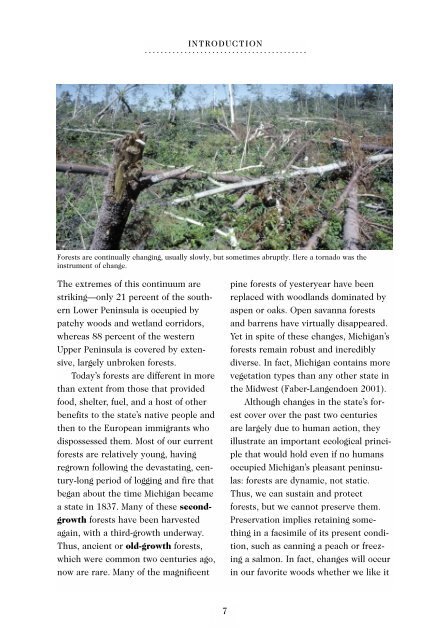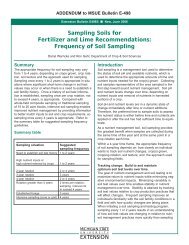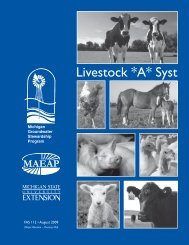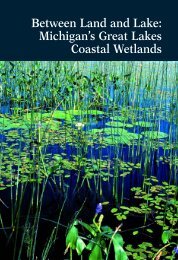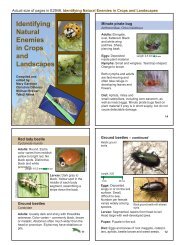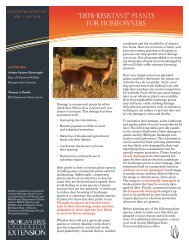Michigan Forest Communities - Michigan Association of ...
Michigan Forest Communities - Michigan Association of ...
Michigan Forest Communities - Michigan Association of ...
You also want an ePaper? Increase the reach of your titles
YUMPU automatically turns print PDFs into web optimized ePapers that Google loves.
INTRODUCTION<br />
<strong>Forest</strong>s are continually changing, usually slowly, but sometimes abruptly. Here a tornado was the<br />
instrument <strong>of</strong> change.<br />
The extremes <strong>of</strong> this continuum are<br />
striking—only 21 percent <strong>of</strong> the southern<br />
Lower Peninsula is occupied by<br />
patchy woods and wetland corridors,<br />
whereas 88 percent <strong>of</strong> the western<br />
Upper Peninsula is covered by extensive,<br />
largely unbroken forests.<br />
Today’s forests are different in more<br />
than extent from those that provided<br />
food, shelter, fuel, and a host <strong>of</strong> other<br />
benefits to the state’s native people and<br />
then to the European immigrants who<br />
dispossessed them. Most <strong>of</strong> our current<br />
forests are relatively young, having<br />
regrown following the devastating, century-long<br />
period <strong>of</strong> logging and fire that<br />
began about the time <strong>Michigan</strong> became<br />
a state in 1837. Many <strong>of</strong> these secondgrowth<br />
forests have been harvested<br />
again, with a third-growth underway.<br />
Thus, ancient or old-growth forests,<br />
which were common two centuries ago,<br />
now are rare. Many <strong>of</strong> the magnificent<br />
pine forests <strong>of</strong> yesteryear have been<br />
replaced with woodlands dominated by<br />
aspen or oaks. Open savanna forests<br />
and barrens have virtually disappeared.<br />
Yet in spite <strong>of</strong> these changes, <strong>Michigan</strong>’s<br />
forests remain robust and incredibly<br />
diverse. In fact, <strong>Michigan</strong> contains more<br />
vegetation types than any other state in<br />
the Midwest (Faber-Langendoen 2001).<br />
Although changes in the state’s forest<br />
cover over the past two centuries<br />
are largely due to human action, they<br />
illustrate an important ecological principle<br />
that would hold even if no humans<br />
occupied <strong>Michigan</strong>’s pleasant peninsulas:<br />
forests are dynamic, not static.<br />
Thus, we can sustain and protect<br />
forests, but we cannot preserve them.<br />
Preservation implies retaining something<br />
in a facsimile <strong>of</strong> its present condition,<br />
such as canning a peach or freezing<br />
a salmon. In fact, changes will occur<br />
in our favorite woods whether we like it<br />
7


